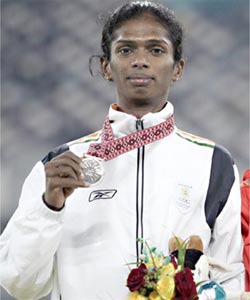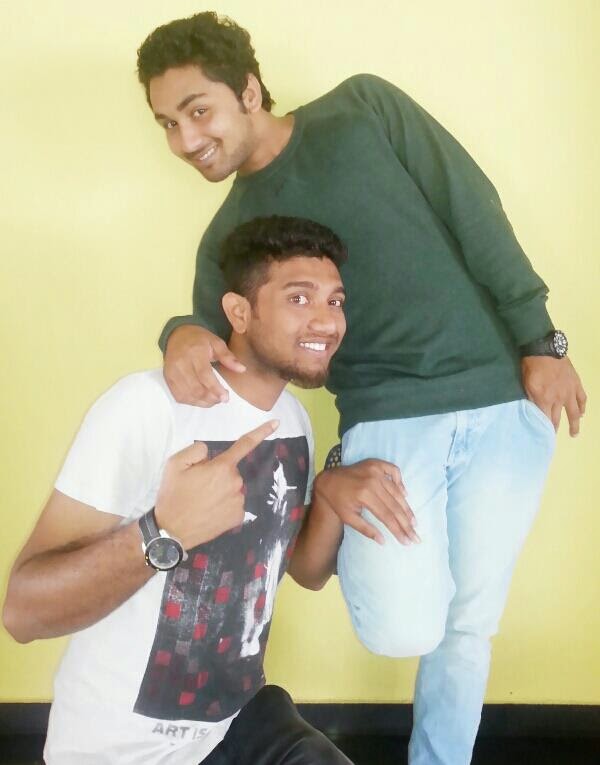“தன் வீட்டில் தொலைக்காட்சி வசதி இல்லாத செளந்திரராஜன், ஊரில் வழக்கமாகத் தொலைக்காட்சி பார்க்கும் அந்த வீட்டின் வாசலில் மறுகியபடி நின்றிருந்தார். மிகுந்த தயக்கத்திற்குப் பின் அங்கு நாடகம் பார்த்துக்கொண்டிருந்த வீட்டுக்காரரிடம் ‘எம்மக இன்னைக்கு ஓட்டப்பந்தயம் ஓடுறா, டிவி’ல காட்டுவாகளாம்… ஒரு அஞ்சு நிமிஷம் பாக்கனும்பா…’ என்றதும் சீரியல் பார்த்த பொதுஜனங்கள் கோபத்தில் சீறத்தொடங்கினார்கள். யாரோ ஒரு நல்ல மனிதரின் கரிசனத்தின் விளைவால், பலபேரின் ‘உச்’களுக்கு மத்தியில் விளையாட்டு சேனல் மாற்றப்பட்டது. சில நிமிடங்களில் தன் மகள் ஓடும் அந்தப் போட்டி திரையில் பளிச்சிட்டது. பல சாதனைகள் புரிந்த வெளிநாட்டு வீராங்கனைகளுக்கு மத்தியில் தன் மகள் கொஞ்சம் கொஞ்சமாக முன்னேறும்போது, தன் மனதிற்குள் ‘வந்திடும்மா சாந்தி…. வந்திடும்மா….’ என்று சொல்ல, எல்லையை அடையும்போது தன் மகள் இரண்டாம் இடம்… மகிழ்ச்சியில் கண்ணீர் பெருக்கெடுத்தது அந்த ஏழை அப்பாவிற்கு…!”

புதுக்கோட்டை சாந்தி 2006இல் தோஹாவில் நடந்த ஆசிய விளையாட்டுப் போட்டியில் வெள்ளிப்பதக்கம் வென்றபோது, ஒரு பிரபல வார இதழில் செய்தி இப்படித்தான் போடப்பட்டிருந்தது. பதினொரு சர்வதேச பதக்கங்கள், ஐம்பதுக்கும் மேற்பட்ட தேசிய பதக்கங்கள் பெற்ற சாந்தியின் ஆசிய விளையாட்டு போட்டி கனவு வென்றதை, தமிழகமே தனக்கான வெற்றியாக நினைத்து கொண்டாடிய தருணங்கள் அவை. ஆசிய அளவிலான போட்டிகளில் மட்டும் 4 தங்கப்பதக்கங்கள், 6 வெள்ளிப்பதக்கங்கள், 1 வெண்கல பதக்கம் என கலந்துகொண்ட போட்டிகள் அனைத்திலும் கழுத்தில் பதக்கத்தோடு திரும்பிய வெற்றி வீராங்கனை இவர். தமிழக அரசின் சார்பில் பதினைந்து லட்சம் பரிசுத்தொகை, பிரம்மாண்ட தொலைக்காட்சி பெட்டி என்று நம் அரசு தன் கடமையை(?) செய்யவும் மறக்கவில்லை.
வறட்சியின் பிடியிலும், வறுமையின் கொடுமையிலும் சிக்கித்தவிக்கும் புதுக்கோட்டை மாவட்டத்தின் கத்தக்குறிச்சியைச் சேர்ந்த சாந்தியின் வறுமையை விளக்க வேண்டுமானால் ஒரு நிகழ்ச்சியைக் கூறினால் போதும். சாந்தியின் வெற்றியை பற்றி அவர் நண்பர் கேட்டபோது, “எங்கப்பா செங்கச்சூலையில் வேலை பார்க்கிறார். தினமும் ஏழு கிலோமீட்டர் வேலைக்கு ஓடிச் சென்று உழைத்துத்தான் எங்களைக் காப்பாற்றினார். எனக்குப் பிறகு இருக்கின்ற மூன்று தங்கைகளையும் என்னையும் காப்பாற்ற என் அப்பா ஓடுவதை நிறுத்த வேண்டுமானால், நான் வேகமாக ஓடவேண்டும் என்ற ஒரே சிந்தனையில்தான் ஓடினேன்…ஓடும்போது சக வீராங்கனைகளைவிட, என் கண்களுக்கு எனது தங்கைகளே தெரிந்தார்கள்” என்றார். தன் கவலைக்கெல்லாம் தீர்வு கிடைத்ததாய் எண்ணி மகிழ்ந்து, அதைக் கொண்டாடும் சூழல் வருவதற்கு முன்பே “பாலின பரிசோதனை” வடிவில் சாந்திக்குச் சோதனை வந்தது. சாந்தியை அப்படி சோதனை செய்யும்போது, தமிழ் தெரிந்த ஒருவரும் அங்கே இல்லை.தான் எதற்காகச் சோதிக்கப்படுகிறோம்? என்ற கேள்விக்கு விடை தெரியாமலேயே, அவரைப் பற்றிய பாலியல் பரிசோதனைக்கான விடையை வெளியிட்டனர் அந்த மருத்துவக் குழுவினர்.
அந்தச் சோதனையில் அவருக்குச் சில ஹார்மோன்கள் அதிகப்படியாக இருப்பதாகவும், அதனால் சாந்தி உடலளவில் ஆண்தன்மை பெற்றவர் எனவும் கூறப்பட்டு, அவருடைய வெள்ளிப்பதக்கம் பறிக்கப்பட்டது. அதுமட்டுமல்லாமல் இனி எந்த விளையாட்டு போட்டிகளிலும் அவர் விளையாட முடியாதபடி தடை விதிக்கப்பட்டது. இந்திய ஊடகங்கள் (குறிப்பாக தமிழ் ஊடகங்கள்) சாந்தியின் பாலின குழப்பத்தை வியாபாரமாக்கின. எந்த வார இதழ் சாந்தியின் பெற்றோரின் உருக்கத்தை வரிவடிவில் பதிவு செய்ததோ, அதே இதழின் அட்டைப்படத்தில் “சாந்தி பெண் இல்லை…!” என்ற தலைப்புடன் செய்தி வெளியிட்டது…. (இப்போதுவரை சாந்தியை இந்த ஊடகங்கள் திருநங்கையாகவே பார்த்து வருவது அறியாமையின் உச்சமென்றே சொல்லலாம்!)
இவ்வளவும் சாந்தி தமிழகம் திரும்புவதற்கு முன்பு நடந்தேறிவிட்டது. இந்தச் செய்திக்கு பிறகு சில நாட்களில் நாம் சாந்தியை மறந்துவிட்டோம். ஒரு பெண்ணின் பாலின அடையாளத்தை மறுப்பது எவ்வளவு பெரிய சீரழிவை நோக்கி சம்பந்தப்பட்ட நபரை கொண்டு செல்லும் என்பது சாந்தி மட்டுமே உணர்ந்த உண்மை. மீண்டும் சில காலத்தில் வறுமையின் பிடியில் சிக்கித் தவித்தார், தன் பெற்றோருடன் செங்கல் சூளையில் தினக்கூலியாக வேலைக்குச் சென்றார் ஆசிய விளையாட்டுப் போட்டியில் பதக்கம் வென்ற அந்த வீராங்கனை. சமூகத்தின் ஏளனப்பார்வையிலும், “எப்போதும் அவருடைய பாலின அடையாளத்தை சந்தேகக்கண் கொண்டு பார்க்கும் சமுதாயத்தின்” அலட்சிய பார்வையிலும் சிக்கித்தவித்த சாந்தி ஒரு நிலையில், பூச்சி மருந்தை உட்கொண்டு தற்கொலைக்கு முயன்றார். மருத்துவமனையில் அனுமதிக்கப்பட்டுத் தீவிர சிகிச்சைக்கு பிறகு காப்பாற்றப்பட்டார்.
“இந்தப் பிரச்சினையால எங்க மத்த பொண்ணுக கல்யாணமும் கேள்விக்குறியா இருக்கு!” என்று புலம்பும் சாந்தியின் அம்மா மணிமேகலையின் ஆதங்கம் நியாயமானது.
“இப்போவல்லாம் அந்தப் போட்டியில் ஏன்தான் ஜெய்ச்சேனோ’ன்னு தோணுது” என்ற சாந்தியின் ஆற்றாமையும் நம்மால் புரிந்துகொள்ள முடியாத வலியின் விளைவுகள். பரிசாகப் பெற்ற பணத்தையும் கூட தடகள பயிற்சிக்கூடம் ஒன்று புதுகையில் தொடங்கியதன் மூலம் விளையாட்டிற்கே செலவழித்தார் சாந்தி. இவருடைய பட்டறையில் பட்டை தீட்டப்பட்ட வைரங்கள் இரண்டு சென்னையில் நடந்த மரத்தான் தொடர் ஓட்டத்தில் முதல் மற்றும் மூன்றாம் இடத்தைப் பிடித்தார்கள். ஆனால், மேற்கொண்டு அந்தப் பயிற்சி மையத்தை தொடர முடியாத அளவிற்கு பண நெருக்கடி ஏற்பட்டதால், மீண்டும் கத்தக்குறிச்சியில் செங்கச்சூலையில் வேலைக்குச் செல்ல வேண்டிய சூழலும் உருவாகிவிட்டது.இப்படி தொடங்கிய இடத்திற்கே திரும்பி வந்துவிட்ட சாந்திக்கு, மிச்சம் கிடைத்தது “இவள் பெண் அல்ல” என்கிற பட்டமும், ஏளனப்பார்வையும் தான். இந்த வார்த்தைகளுக்குப் பின்னால் குற்றவாளியாக நாம்தான் இருக்கிறோம் என்பதை நாம் இன்னும் உணரவில்லை.
தென்னாப்ரிக்காவைச் சேர்ந்த தடகள வீராங்கனை காஸ்டர் செமன்யா என்கிற வீராங்கனையும் இதே போன்ற பாலின பரிசோதனையால் பதக்கம் பறிக்கப்பட்டவர்தான். 2009 பெர்லினில் நடந்த உலக சாம்பியன்ஷிப் போட்டியில் தங்கம் வென்ற செமன்யாவின் பதக்கம், அந்த சோதனைக்கு பிறகு பறிக்கப்பட்டது. ஆனால், அதன் பின் நடந்தது என்ன தெரியுமா? நாடு திரும்பிய செமன்யாவை தென்னாப்ரிக்க விளையாட்டுத்துறை அமைச்சர் நேரில் சென்று ‘தாங்கள் இருப்பதாக’ ஆறுதல் கூறினார். தென்னாப்ரிக்க பிரதமர் செமன்யாவிற்கு ஆதரவாக, அந்தச் சோதனையை எதிர்த்து கடுமையான எதிர்ப்பை பதிவுசெய்தார். அந்நாட்டு அரசே அவருக்கு ஆதரவாக ஐக்கிய நாடுகள் அவையில் வழக்கு தொடர்ந்து, வெற்றியும் கண்டது. 2012ஆம் ஆண்டு லண்டனில் நடந்த ஒலிம்பிக் போட்டிகளின் தொடக்க விழாவில், தென்னாப்ரிக்காவின் சார்பாக அந்நாட்டு கொடியை கையில் ஏந்தி சென்றவர் அதே காஸ்டர் செமன்யாதான்.
மூன்று ஆண்டுகளில் அந்தப் பெண்ணுக்கு நியாயம் கிடைத்தது.எட்டு வருடங்களில் சாந்தி அனுபவித்த கொடுமைகளோடு, செமன்யாவின் மூன்று வருட யுத்தத்தின் வெற்றியை தொடர்புபடுத்திப் பார்த்தாலே, நாம் எதைச் செய்ய தவறினோம் என்பது நமக்கு புரியும். இதுவரை சாந்திக்காக மத்திய அரசு, மாநில அரசு மட்டுமல்ல மாவட்ட நிர்வாகம் கூட பக்கபலமாக நிற்கவில்லை என்பதுதான் நாம் வெட்கி தலைகுனிய வேண்டிய உண்மை. சில லட்சங்கள் பரிசோடு சாந்தியை நாம் மறந்துவிட்டோம், ஒரு நல்லரசின் கடமையை தென்னாப்ரிக்காவை பார்த்து நாம் கற்றுக்கொள்ள வேண்டிய நிலைதான் உள்ளது.
 |
Santhi Soundarajan at The American College, Madurai
© Srishti Madurai |
“ஒரு தலித் பெண்ணாகவும், ஏழையாகவும் இருப்பதால்தான் நான் கண்டுகொள்ளப்படவில்லை. ஒருவேளை அரசை உலுக்கும் அளவிற்கு எனக்குச் சாதி பின்புலமா, பண பலமோ இருந்திருந்தால் நான் கண்டுகொள்ளப்பட்டிருக்கலாம்….” கண்கள் கலங்க சாந்தி சொன்ன இந்த வார்த்தைகளில் நிச்சயம் உண்மை இருக்கவே செய்கிறது.
நீண்ட காலமாகவே பாலின பரிசோதனையின் நம்பகத்தன்மை பற்றி பல அறிவியல் அறிஞர்களும் விமர்சித்தே வருகின்றனர். ஒரு மனிதனின் பிறப்புறுப்பை வைத்து மட்டுமே குறிப்பிட்ட மனிதரின் பாலின அடையாளத்தை வரையறுக்க முடியாது, அதே போல குரோமோசோம் அமைப்பை பொருத்து மட்டுமே கூட பாலின அடையாளத்தை அறுதியிட்டு கூறமுடியாது. விளையாட்டு வீரர்களின் உடலிலிருந்து சில திசுக்களை எடுத்து, அதில் இரண்டு X குரோமோசோம்கள் இருக்கிறதா என்பதைக் கண்டறிந்தார்கள். அப்படி இரண்டு எக்ஸ் குரோமோசோம்கள் (XX) கண்டறியப்பட்டால், குறிப்பிட்ட மனிதரை பெண் என்று வரையறுத்தார்கள். ஆனால், அறிவியலின்படி XXY குரோமோசோம் அமைப்பு பெற்ற ஆண்களும் உண்டு, ஒரே எக்ஸ் குரோமோசோம் அமையப்பற்ற பெண்களும் உண்டு.
இவை மருத்துவக் குறைபாடுகள்தானே தவிர, பாலின வேறுபாடு இல்லை என்பதைப் பலரும் குறிப்பிடுகிறார்கள். அதனால் XX குரோமோசோம்கள் திசுக்களில் இருப்பதை வைத்து பாலின அடையாளத்தைத் தீர்மானிப்பது பலராலும் எதிர்க்கப்பட்டது. அதன்பின்பு SRY எனப்படும் மரபணு உடலில் இருக்கிறதா? என்ற பரிசோதனை செய்யத் தொடங்கினார்கள். அதாவது குறிப்பிட்ட அந்த மரபணு ஆண்களுக்கு இருக்கும் Y குரோமோசோமில் மட்டுமே காணப்படும் என்பதால், அந்த மரபணு காணப்படும் விளையாட்டு வீரர்கள் பெண்களுக்குரிய போட்டியில் கலந்துகொள்ளத் தடைவிதிக்கப்பட்டது. மேலோட்டமாக பார்த்தால், இது சரியாகத் தெரிந்தாலும் குறிப்பிட்ட SRY மரபணு பற்றி முழுமையாக நாம் தெரிந்துகொள்ளும்போது அதன் குழப்பமான இருப்பை நம்மால் உணரமுடியும்… அதாவது, ஒரு குழந்தை கருவில் இருக்கும்போதே அதன் பாலினம் தீர்மானிக்கப்படுகிறது… நாம் மேற்சொன்ன அந்த மரபணுதான் விரை உருவாவதற்கும், அதிலிருந்து டெஸ்ட்டோஸ்டீரோன் எனப்படும் ஹார்மோன் உருவாவதற்கும் காரணியாகச் செயல்படுகிறது. இந்த ஹார்மோன்தான் கருவை ஆண் குழந்தையாக உருவாக்குகிறது. Y க்ரோமோசம் இருப்பதாலும், SRY மரபணு இருப்பதாலும் மட்டுமே ஒருவரை ஆண் என்று வரையறுக்க முடியாது.
உடலியல் மற்றும் உயிரியல் ரீதியாக பிறக்கும் பெண் குழந்தைக்கும் கூட ஒய் குரோமோசோம் இருப்பதற்கான வாய்ப்புண்டு. அப்படிப்பட்ட பெண்களுக்கு ஒய் க்ரோமோசம் இருக்கலாம், SRY மரபணு இருக்கலாம், அவ்வளவு ஏன் டெஸ்ட்டோஸ்டீரோன் கூட இருக்கலாம். ஆனால், அந்த ஹார்மோன் செயலாற்ற தேவையான காரணிகள் இல்லாததால், அவற்றால் கருவை ஆண் குழந்தையாக்க முடியாது. ஆகையால், அந்த கரு பெண் குழந்தையாகத்தான் உருவாகும், தன்னை அப்படித்தான் உணரும்… இந்த நிலைக்கு மருத்துவப் பெயராக “ஆண்ட்ரோஜென் இன்சென்சிடிவிடி சிண்ட்ரோம் (androgen insensitivity syndrome)” என்று பெயர். சாந்திக்கு இருப்பதும் இந்தப் பிரச்சினைதான். அவருக்கும் ஒய், குரோமோசோம், SRY மரபணு, டெஸ்ட்டோஸ்டீரோன் ஹார்மோன் எல்லாம் இருந்தும் அவை செயலற்ற நிலையில் இருப்பவையே. கருவில் இருந்தது முதல் இப்போது வரை அவர் பெண் தான் என்பதில் எவ்வித மாற்றமும் இல்லை.
1990களில் இருந்தே பாலின சோதனை தொடர்பாக குழப்பமான மனநிலையில்தான் ஒலிம்பிக் கமிட்டி இருந்துவருகிறது… இந்தக் குழப்பத்தைச் சாதகமாக்கித்தான் செமன்யாவிற்கு அந்நாட்டு அரசு நியாயம் பெற்றுத்தந்தது. ஆனால், சாந்தி விஷயத்தை நம்மவர்கள் யோசிக்கக்கூட நினைக்கவில்லை.
“எனக்கு சச்சின் டெண்டுல்கரை யார் என்று தெரியாது” என்று சொன்ன மரியா ஷரபோவா’வை கரித்துக் கொட்டும் நம்மில் எத்தனை பேர் சாந்தியை நினைவில் வைத்திருந்தோம்?
“எனக்கு சாந்தியை தெரியாது!” என்று சொல்வதில் நமக்கு கொஞ்சமும் உறுத்தல் இருப்பதில்லை. ஒரு விளையாட்டு வீராங்கனை தான் பதக்கம் வென்றதற்காக வருத்தப்படும் சூழல் நிலவும் ஒரே நாடு நம் நாடாகத்தான் இருக்கும். கடந்த ஆண்டு பெங்களூருவில் விளையாட்டுப் பயிற்சியாளர்களுக்கான படிப்பில் சேர்ந்த சாந்தி, இரண்டு மாதங்களுக்கு முன்பு அதற்கான சான்றிதழை பெற்றார். சாந்தியை போன்ற வீராங்கனைகளை இனியாவது ஊக்குவித்து, வாய்ப்புகளை ஏற்படுத்திக் கொடுத்தால் மட்டுமே “ஒரு வெண்கல பதக்கத்திற்காக ஒலிம்பிக் பதக்கப் பட்டியலை ஏக்கத்தோடு பார்த்திடும்” இந்தியனின் கனவு நிறைவேறும். இப்போதுவரை சாந்தியின் வீட்டில் கழிப்பறை வசதி கூட இல்லை, முறையான மின்சார வசதி இல்லை. அதுமட்டுமல்ல, அத்திப்பூத்தாற் போலத்தான் மூன்று வேளை உணவு கூட அவருக்குச் சாத்தியமாகிறது.
“ஒலிம்பிக்கில் பதக்கம் வெல்ல வேண்டும்!” என்ற கனவோடு விளையாட்டில் கால்பதித்த சாந்தியின் கனவு இப்போதெல்லாம், “தங்கைகளின் திருமணம், அப்பா அம்மாவை உட்கார வைத்து சாப்பாடு போடணும்!” என்கிற அளவுக்குச் சுருங்கிவிட்டது.சாந்தியை நாம் உருவாக்க தவறிவிட்டோம், இனி சாந்தியை போன்ற விளையாட்டு வீரர்களை அவரே உருவாக்கும் வகையில் சிறப்பான களம் அமைத்துக்கொடுக்கவும், வாய்ப்பு கொடுத்திடவும் மத்திய மாநில அரசுகளை கைகூப்பிக் கேட்டுக்கொள்கிறேன்….!





 புதுக்கோட்டை சாந்தி 2006இல் தோஹாவில் நடந்த ஆசிய விளையாட்டுப் போட்டியில் வெள்ளிப்பதக்கம் வென்றபோது, ஒரு பிரபல வார இதழில் செய்தி இப்படித்தான் போடப்பட்டிருந்தது. பதினொரு சர்வதேச பதக்கங்கள், ஐம்பதுக்கும் மேற்பட்ட தேசிய பதக்கங்கள் பெற்ற சாந்தியின் ஆசிய விளையாட்டு போட்டி கனவு வென்றதை, தமிழகமே தனக்கான வெற்றியாக நினைத்து கொண்டாடிய தருணங்கள் அவை. ஆசிய அளவிலான போட்டிகளில் மட்டும் 4 தங்கப்பதக்கங்கள், 6 வெள்ளிப்பதக்கங்கள், 1 வெண்கல பதக்கம் என கலந்துகொண்ட போட்டிகள் அனைத்திலும் கழுத்தில் பதக்கத்தோடு திரும்பிய வெற்றி வீராங்கனை இவர். தமிழக அரசின் சார்பில் பதினைந்து லட்சம் பரிசுத்தொகை, பிரம்மாண்ட தொலைக்காட்சி பெட்டி என்று நம் அரசு தன் கடமையை(?) செய்யவும் மறக்கவில்லை.
புதுக்கோட்டை சாந்தி 2006இல் தோஹாவில் நடந்த ஆசிய விளையாட்டுப் போட்டியில் வெள்ளிப்பதக்கம் வென்றபோது, ஒரு பிரபல வார இதழில் செய்தி இப்படித்தான் போடப்பட்டிருந்தது. பதினொரு சர்வதேச பதக்கங்கள், ஐம்பதுக்கும் மேற்பட்ட தேசிய பதக்கங்கள் பெற்ற சாந்தியின் ஆசிய விளையாட்டு போட்டி கனவு வென்றதை, தமிழகமே தனக்கான வெற்றியாக நினைத்து கொண்டாடிய தருணங்கள் அவை. ஆசிய அளவிலான போட்டிகளில் மட்டும் 4 தங்கப்பதக்கங்கள், 6 வெள்ளிப்பதக்கங்கள், 1 வெண்கல பதக்கம் என கலந்துகொண்ட போட்டிகள் அனைத்திலும் கழுத்தில் பதக்கத்தோடு திரும்பிய வெற்றி வீராங்கனை இவர். தமிழக அரசின் சார்பில் பதினைந்து லட்சம் பரிசுத்தொகை, பிரம்மாண்ட தொலைக்காட்சி பெட்டி என்று நம் அரசு தன் கடமையை(?) செய்யவும் மறக்கவில்லை.





